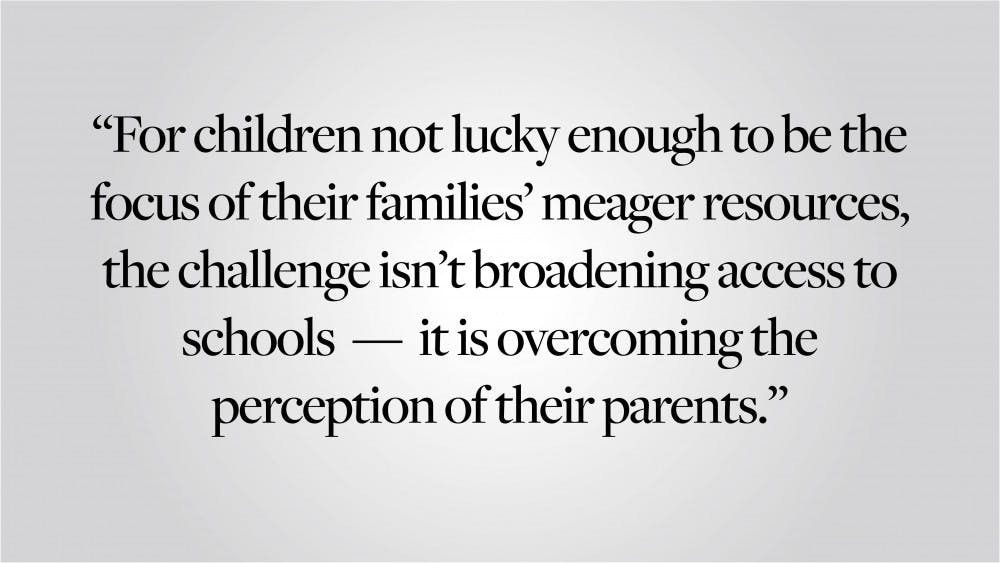Organizations such as the World Bank, United States Agency for International Development or UNICEF rightfully focus on inequalities at the country, province and village levels in their quest to improve lives. But inequality also stems from an even smaller economic agent: the household. For children not lucky enough to be the focus of their families’ meager resources, the challenge isn’t broadening access to schools — it is overcoming the perceptions of their parents that deem them worthy or unworthy of an education. An incorrect assumption that returns on early education are not large enough to compensate for the cost of school attendance drives families to concentrate their spending on one child, ensuring that they finish high school. Parents are not acting on favoritism. They are simply trying to give their families a better future by ensuring that at least one of their children receives the returns promised by secondary education. While governments and nonprofits have made enormous strides in giving children across the low-income world access to schools, their next obstacle is making sure parents are giving their kids the opportunity to attend. When these parents pick winners, millions of children are left behind.
The financial constraints that families face across the world, and especially in developing countries, force families to make hard choices about which children they will send to school. In their book, “Poor Economics,” economists Abhijit Banerjee and Esther Duflo explore this phenomenon. They recall a strange conversation with a mother of seven in the agricultural village of Naganadgi, India. She explained that six of her children had quit school by the second grade. Her youngest, however, was a seventh-grader at an expensive private boarding school. What surprised Banerjee and Duflo most was the mother’s candor about her children’s abilities. The youngest child, she said, was the only “intelligent” one — the others were “stupid.” Read from the United States, where education is free and compulsory, her words are jarring. But they are also consistent with a worldview that is common in poor countries that encourages families to concentrate limited resources on a single child with a high perceived chance of success. Because of misguided perceptions questioning the future payoff of education, parents across the low-income world invest in their offspring according to each child’s relative potential — robbing children perceived as unintelligent of social mobility before they even leave grade school.
Education is a disproportionate burden on family budgets in poor countries, of which secondary education can amount to more than a quarter, compared to no more than 5% in most high-income countries, according to the World Bank. With this cost in mind, it’s no surprise that the family dynamics Banerjee and Duflo encountered are far from unique to Naganadgi. Using data from Burkina Faso, economists Richard Akresh, Emilie Bagby, Damien de Walque and Harounan Kazianga noticed significant variation in enrollment within families — in 54% of households, some children had attended school while some had not. The authors studied this intrafamily variation to better understand the factors that influence parents’ decisions to educate their children. First, they evaluated children’s cognitive skills, then they examined parents’ perceptions of their offspring’s future prospects using a survey. Strikingly, a child was less likely to be enrolled if they had siblings perceived to have a higher chance of future success. Having at least one such sibling decreased a child’s likelihood of enrollment by seven percent. Parents seem to base their evaluations at least in part on their observations of cognitive aptitude. They found that a child with cognitive ability measured at one standard deviation higher than the average of their siblings was 30% more likely to be enrolled in school. Parents really were, as Banerjee and Duflo argued, putting “all their educational eggs’’ in one basket. And given that families in many poor countries face similar financial constraints on getting their children educated, it is likely that this approach — parental investment in children according to their relative potentials — is common across the world, and therefore ought to be in the forefront of efforts to build educational capacity in poor countries.
Having to single out one child to bear their hopes for financial success has implications even beyond family spending on education; the forces that drive families to choose which children go to school also play a role in determining which resources children have access to. Because it is difficult to observe the allocation of resources like food and medicine within families, researchers Mark Rosenzweig and T. Paul Schultz instead measured childrens’ survival rates in rural India; those who survived, the authors assumed, had received more resources. In virtually all areas, boys were more likely to survive than girls. The authors reasoned that this was a result of parents’ higher perceptions of boys’ earning potentials. To test this hypothesis, Rosenzweig and Schultz next examined areas where women had relatively better earning potential and more economic opportunities. In these areas, the gap in survival rates was smaller, proving that parents really were allocating resources which would support academic performance according to perceived likelihood of success.
Humanitarian intervention at its best takes into account the worldview and values of those it’s trying to help. If the goal is to increase the educational opportunities of these countries, aid organizations like UNICEF need to understand not just the regional manifestations of problems but the domestic ones as well. This includes understanding the decision making processes that put some kids in school and keep others at home — only then can they deliver truly holistic educational aid.
Arjun Shanmugam ’23 can be reached at arjun_shanmugam@brown.edu. Please send responses to this opinion to letters@browndailyherald.com and op-eds to opinions@browndailyherald.com.





